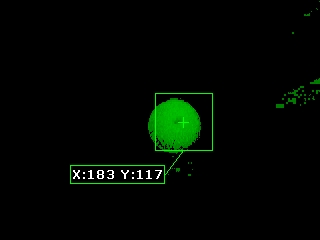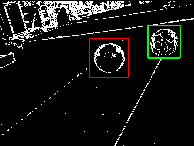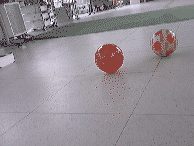

DEVELOPMENT
Ball tracking
Color Tracking

Shape traking


Hough transform
The Hough transform (pronounced /hʌf/) is a feature extraction technique used in digital image processing. The classical transform identifies lines in the image, but it has been extended to identifying positions of arbitrary shapes.
The Hough transform can be used for representing objects besides lines. For instance, a circle can be parameterized as
![]()
Here, (a,b) is the coordinate of the centr of the circle that passes through (x,y), and ![]() is its radius . Since there are three parameters for this equation, it follows that the Hough transform will be a three-dimensional image. Therefore circles require more computation to find than lines. For this reason the Hough transform is more typically used for simpler curves, such as straight lines and parabolas .
is its radius . Since there are three parameters for this equation, it follows that the Hough transform will be a three-dimensional image. Therefore circles require more computation to find than lines. For this reason the Hough transform is more typically used for simpler curves, such as straight lines and parabolas .
Velocity
Velocity is defined as the rate of change of displacement or the rate of displacement. It is a vector physical quantity, both speed and direction are required to define it. In the SI (metric) system, it is measured in meters per second (m/s). The scalar absolute value (magnitude) of velocity is speed. For example, "5 metres per second" is a speed and not a vector, whereas "5 metres per second east" is a vector. The average velocity (v) of an object moving a displacement (s) in a straight line during a time interval (t) is described by the formula
![]()
Simply put, velocity is distance per units of time.
Annotation
In the digital imaging community the term annotation is commonly used for visible metadata superimposed on an image without changing the underlying raster image, such as sticky notes, virtual laser pointers, circles, arrows, and black-outs (cf. redaction).
Open CV
OpenCV is an open source computer vision library originally developed by Intel. It is free for commercial and research use under a BSD license. The library is cross-platform, and runs on Mac OS X, Windows and Linux. It focuses mainly towards real-time image processing, as such, if it finds Intel's Integrated Performance Primitives on the system, it will use these commercial optimized routines to accelerate itself.
C++
C++ is a general-purpose, middle-level programming language with high-level and low-level capabilities. It is a statically typed free-form multi-paradigm language, supporting procedural programming, data abstraction, object-oriented programming, and generic programming. Since the 1990s, C++ has been one of the most popular commercial programming languages.